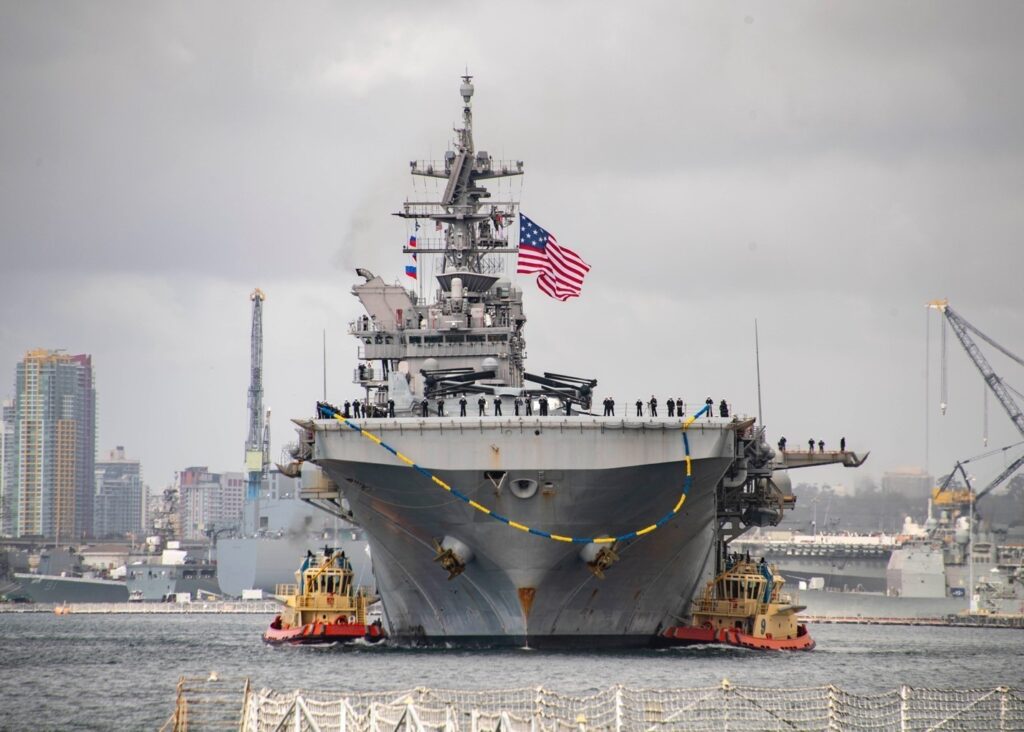
SAN DIEGO — USS Tripoli’s deployment to the U.S. 3rd and 7th Fleet areas of operations was particularly significant for its diplomatic and military engagements with regional partners and Allies, as well as successful integration with the 31st Marine Expeditionary Unit (MEU) to support maritime security operations, theater security cooperation, crisis response and maintaining a forward Navy-Marine Corps presence, Expeditionary Strike Group Three said in a Nov. 30 release.
“I am proud of Tripoli for a successful first deployment,” said Rear Adm. James Kirk, commander, Expeditionary Strike Group (ESG) 3. “The ship and crew are on the leading edge, setting the example and testing the limits of the assault ship. LHAs are designed to support the future of the Marine Corps Air Combat Element, and Tripoli has done just that. I am excited to see what else they can bring to the fight.”
The U.S. Marine Corps embarked 16 F-35Bs aboard Tripoli, which flew missions in support of exercises Valiant Shield 22 and Noble Fusion. The Navy and Marine Corps team seamlessly integrated to complete training and certification exercises before joining the Armed Forces of the Philippines for bilateral exercise Kamandag 2022. Overall, the crew completed 2,052 hours of flight operations and traveled 40,303 nautical miles during exercise support. Tripoli operated alongside other partners and Allies throughout the Indo-Pacific during the deployment, including Japan and the Republic of Singapore. Port calls included stops in Tasmania, Australia, Japan, Singapore and the Philippines.
“The Sailors and Marines aboard Tripoli went above and beyond during this deployment to demonstrate the unique capabilities of this ship,” said Capt. John C. Kiefaber, Tripoli’s commanding officer. “Whether it was launching and recovering aircraft at night, acting as a base of operations for the 31st Marine Expeditionary Unit to conduct operations ashore or serving as an instrument of diplomacy to our ally and partner nations, the crew performed their duties professionally and demonstrated why they are the Navy’s greatest asset. I couldn’t be more proud.”
During the deployment, 140 Tripoli Sailors advanced to the next highest paygrade. The crew also excelled at earning individual qualifications; more than 167 Sailors earned their Enlisted Surface Warfare Specialist (ESWS) qualification, 192 Sailors earned their Enlisted Air Warfare Specialist (EAWS) qualification and 3 Sailors earned their Enlisted Information Warfare Specialist (EIWS) qualification, a new program for Tripoli. In the Wardroom, 12 officers earned their Surface Warfare Officer qualification, three officers earned their Surface Warfare Supply Corps Officer qualification, two officers earned their Naval Aviation Supply Officer qualification, four officers earned their Surface Warfare Medical Department Officer qualification and 16 officers earned their Officer of the Deck (Underway) qualification.
“A Sailor earning their primary warfare pin is a great way for them to better themselves and it’s a milestone in their career, but also it’s important Sailors have a deeper understanding of the role that they and their shipmates play in the ship’s operations,” said Command Master Chief Matthew Logsdon.
Tripoli, an America-class amphibious assault ship, commissioned in July 2020. The ship is homeported in San Diego and operates under ESG 3. Amphibious assault ships provide the ability to operate seamlessly and simultaneously on the sea, ashore and in the air allowing the integration of forces to be distributed more broadly, and increasing operational unpredictability anywhere around the globe by varying our domain, forces and timing.
ESG 3 comprises four amphibious squadrons, 15 amphibious warships and eight naval support elements including approximately 18,000 active-duty and reserve Sailors and Marines. As deputy commander for Amphibious and Littoral Warfare, U.S. 3rd Fleet; Commander, ESG 3 also oversees Mine Countermeasures Group 3 and the 14 littoral combat ships and tow subordinate divisions under Littoral Combat Ship Squadron 1. ESG 3 is postured in support of U.S. 3rd Fleet as a globally responsive and scalable naval command element, capable of generating, deploying, and employing naval forces and formations for crisis and contingency response, forward presence, and major combat operations focusing on amphibious operations, humanitarian and disaster relief and support to defense civil authorities, and expeditionary logistics.
- Indian Navy Carries Out First Drug Interdiction as CMF Member - April 16, 2024
- Defense of Israel Activities Update - April 15, 2024
- IDF Announces Rafael’s C-Dome First Combat Interception of Hostile Target at Sea - April 12, 2024






